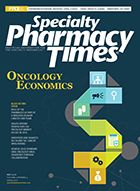Publication
Article
Specialty Pharmacy Times
Why Is CAR T Therapy the Next Step for Oncology?
CAR T-cell immunotherapy is being hailed as the fifth pillar of cancer treatment.
As this edition of Specialty Pharmacy Times® places the spotlight on oncology, it’s a good time to discuss a new form of therapy for certain cancers called chimeric antigen receptor (CAR) T-cell therapy. This revolutionary immunotherapy strengthens the immune system to attack tumors, and this drug class is being hailed as the “fifth pillar” of cancer treatment.
So, what is CAR T-cell therapy and how does it work? According to Memorial Sloan Kettering Cancer Center, CAR T-cell therapy involves arming immune cells with proteins that help identify cancer. After being infused into the patient, CAR T cells persist in the body to become “living drugs.”1
At the heart of this treatment are T cells, a valuable part of the immune system due to the role they play in orchestrating immune response and in killing cells infected by pathogens. CAR T-cell therapy requires drawing blood from patients and separating out the T cells. Using a disarmed virus, the T cells are genetically engineered to produce CARs on their surface.
These special receptors allow T cells to recognize and attach to an antigen on tumor cells. The CAR T-cell therapies that are furthest along in development target an antigen found on B cells called CD19. Once the collected T cells have been engineered to express the antigen-specific CAR, they are expanded in the laboratory into hundreds of millions.
The final step is the infusion of the CAR T cells back into the patient. If the procedure goes according to plan, the engineered cells further multiply in the patient’s body and, with guidance from their engineered receptor, identify and eliminate cancer cells that carry the antigen on their surfaces.2
Currently, CAR T-cell therapy development has focused mainly on children with acute lymphoblastic leukemia (ALL), which is the most common form of childhood cancer. The results have been promising among both children and adult patients with certain blood cancers.
The National Cancer Institute has also commented on CAR T-cell therapy: “Until recently, the use of CAR T-cell therapy has been restricted to small clinical trials, largely in patients with advanced blood cancers. But these treatments have nevertheless captured the attention of researchers and the public alike because of the remarkable responses they have produced in some patients—both children and adults—for whom all other treatments had stopped working.”
Last year, 2 CAR T-cell therapies were approved by the FDA, 1 for the treatment of children with ALL and the other for adults with advanced lymphomas. Nevertheless, researchers caution that, in many respects, these are still the early days for the development of CAR T-cell therapy, as well as for other forms of chemotherapy combinations, such as doxorubicin hydrochloride (Adriamycin) and cyclophosphamide, followed by paclitaxel (Taxol). Among other questions, scientists are investigating whether these treatments will ever be effective against solid tumors such as breast and colorectal cancer.2 So, what about the newly approved CAR T-cell therapies on the market? A significant milestone was achieved on August 30, 2017, when the FDA issued a historic approval for the first gene therapy available in the United States, Novartis’ Kymriah (tisagenlecleucel), for certain pediatric and young adult patients with a form of ALL.
Kymriah, a cell-based gene therapy, is approved for the treatment of patients aged up to 25 years who have B-cell precursor ALL that is refractory or in second or later relapse. It has also been granted priority review and breakthrough therapy designations. Additionally, the FDA expanded the approval of Roche’s Actemra (tocilizumab) to treat CAR T-cell—induced severe or life-threatening cytokine-release syndrome (CRS) in patients 2 years or older. In clinical trials of patients treated with CAR T cells, 69% showed a complete resolution of CRS within 2 weeks following up to 2 doses of Actemra.
The FDA surprised the market again in October 2017 when it approved a second CAR T-cell therapy, axicabtagene ciloleucel (Yescarta). Yescarta is indicated for patients with large B-cell lymphomas whose cancer progressed after receiving at least 2 prior treatment regimens.3 According to the FDA, diffuse large B-cell lymphoma is the most common type of non-Hodgkin lymphoma (NHL) in adults, with approximately 72,000 new cases of NHL diagnosed annually in the United States.4
However, with almost all new therapies come adverse effects (AEs), some that are potentially fatal. One of the most frequently reported with CAR-T therapy is CRS. Another potential AE of CAR T-cell therapy—an off-target effect—is a mass die-off of B cells, known as B-cell aplasia. Lastly, another serious and potentially fatal AE, cerebral edema, has been seen in some of the larger trials conducted to support the potential FDA approval of CAR T-cell therapies for patients with advanced leukemias.
In conclusion, strong evidence indicates that CAR T-cell therapy is here to stay. Although several high-profile companies have experienced setbacks in this area, products such as these have shown too much promise to not believe that other manufacturers will attempt to either introduce products in this space or acquire companies that are working on CAR T-cell medications.
References
- Memorial Sloan Kettering Cancer Center. What is CAR T? https://www.mskcc.org/car-cell-therapy
- National Cancer Institute. CAR T Cells: Engineering Patients’ Immune Cells to Treat Their Cancers https://www.cancer.gov/about-cancer/treatment/research/car-t-cells
- National Cancer Institut.e With FDA Approval for Advanced Lymphoma, Second CAR T-Cell Therapy Moves to the Clinic https://www.cancer.gov/news-events/cancer-currents-blog/2017/yescarta-fda-lymphoma
- U.S. Food & Drug Administration. FDA approves CAR-T cell therapy to treat adults with certain types of large B-cell lymphoma https://www.fda.gov/NewsEvents/Newsroom/PressAnnouncements/ucm581216.htm







